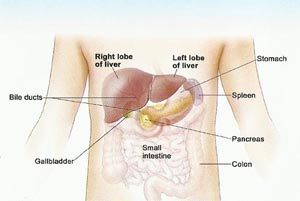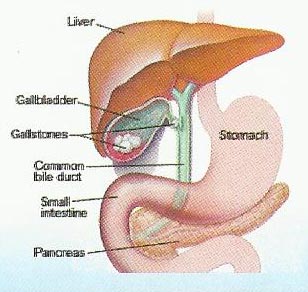Patient Education :
GALLSTONES - LAPAROSCOPIC CHOLECYSTECTOMY

BILE :
The liver is the largest gland in the body, and controls the metabolism. As a result, waste substances are released in a liquid called bile (gall). Bile includes cholesterol (in a different form to that circulating in the blood), bile pigments which colour the bile yellow-brown, and bile salts needed for digestion. The liver produces up to three cups of bile per day. Apart from getting rid of waste, bile has an essential action as a detergent to dissolve fats from food so that they can be digested properly. Bile passes through a series of tubes called the bile ducts, which lead it from the liver to the gut. About halfway down the bile duct, there is a side alley leading to the gallbladder.
THE GALLBLADDER :
The gallbladder is a small pear-shaped bag located beneath the liver on the right side of the abdomen. The gallbladder stores bile, and concentrates it holding ready for digestion. The gallbladder can store up to one cup of concentrated bile. Shortly after eating a meal, the gallbladder squeezes and its bile is released back into the bile duct, and then into the gut. Bile helps fat digestion, and some bile is reabsorbed, returning to the liver, whilst the waste materials within it are eliminated from the body in the stools - which is why they are usually coloured brown.
GALLSTONES :
Gallstones are solid pieces of material that form in the gallbladder, and are usually a little softer than stones. Around one in ten people have gallstones, most commonly as they get into mid-life. Women develop gallstones more commonly than men and at a younger age. Gallstones vary in size and may be as small as sand grains or as large as a plum. The gallbladder may develop a single, often large, stone or many smaller ones, even several thousand. As the gallbladder concentrates bile, it can cause cholesterol and/or bile pigments to crystallise, eventually growing large enough to form gallstones. This can be encouraged by a combination of factors, including inherited body chemistry, body weight, sluggish gallbladder movement, and perhaps diet. Some proteins in bile can promote or inhibit cholesterol crystallisation. Obesity is a major risk factor for gallstones, with a large clinical study showing that even being moderately overweight increases the risk of developing gallstones, probably because it causes excess cholesterol in bile, low bile salts, and decreased gallbladder emptying. Curiously, very low calorie, rapid weight-loss diets, and prolonged fasting, seem to also cause gallstone formation. Increased levels of the female hormone oestrogen, from pregnancy, hormone therapy, or contraceptive pills may increase bile cholesterol levels and decrease gallbladder emptying. Low-fibre (roughage), high-cholesterol diets, and diets high in starchy foods have been suggested as contributing to gallstone formation. Cholesterol stones are white or yellow and make up about 80% of gallstones, but most are mixed and contain some pigment. They develop when bile contains an imbalance, with too much cholesterol and not enough bile salts. Pure pigment stones are small, dark and made of bilirubin, accounting for the other 20%, and may result from cirrhosis, biliary tract infections, and hereditary blood cell disorders, such as sickle cell anaemia or spherocytosis.
WHAT DISEASES CAN GALLSTONES CAUSE?
 Most people with gallstones do not know they have them, as they do not experience any trouble from them. However, gallstones can lead to gallbladder pain, or leave the gallbladder and enter the bile duct, also causing blockage leading to (yellow) jaundice, inflammation with rigors (shivering), or acute pancreatitis. Gallbladder pain can be caused by muscular spasm when the gallbladder attempts to expel the stones (biliary colic), or more seriously, irritation or inflammation due to infection (acute cholecystitis). The pain varies from a brief feeling of indigestion after eating, to severe attacks of up to several hours duration, with nausea, vomiting or belching, and sometimes bloating. Pain is usually felt in the middle or right side of the upper abdomen, and sometimes, due to the way the gallbladder develops in early life, pain can be 'referred' around the right rib margin pain to the back and around the shoulder or shoulder blade. In jaundice bile cannot flow into the gut and spills into the blood, causing a yellow skin and eye colour. Digestion is also impaired causing bloating, the stools turn a putty colour, and due to the overspill into blood, some, urine becomes dark. Bile infection can occur in this situation causing 'rigors' or severe shivering attacks.
Most people with gallstones do not know they have them, as they do not experience any trouble from them. However, gallstones can lead to gallbladder pain, or leave the gallbladder and enter the bile duct, also causing blockage leading to (yellow) jaundice, inflammation with rigors (shivering), or acute pancreatitis. Gallbladder pain can be caused by muscular spasm when the gallbladder attempts to expel the stones (biliary colic), or more seriously, irritation or inflammation due to infection (acute cholecystitis). The pain varies from a brief feeling of indigestion after eating, to severe attacks of up to several hours duration, with nausea, vomiting or belching, and sometimes bloating. Pain is usually felt in the middle or right side of the upper abdomen, and sometimes, due to the way the gallbladder develops in early life, pain can be 'referred' around the right rib margin pain to the back and around the shoulder or shoulder blade. In jaundice bile cannot flow into the gut and spills into the blood, causing a yellow skin and eye colour. Digestion is also impaired causing bloating, the stools turn a putty colour, and due to the overspill into blood, some, urine becomes dark. Bile infection can occur in this situation causing 'rigors' or severe shivering attacks.
